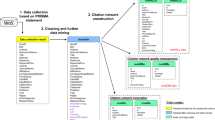Abstract
An approach for evaluation of research is described that integrates output indicators of four stages downstream the innovation process: immediate, intermediate, pre- ultimate and ultimate outputs. Indexes of leading output indicators are constructed. The indexes are integrated cumulatively to form an overall index of key output indicators, which is the integrated figure of merit (IFM). Data for the indicators are obtained from records and key informants, and the indicators are grouped by normalized weights. The paper also discusses the limitations and the methodological, conceptual and political/organizational issues of such an approach to research evaluation.
Similar content being viewed by others
References
R. N. Kostoff, Research impact assessment: Problems, progress, promise,Proceedings of the Fourth International Conference on Management of Technology, Miami, Florida, February 27–March 4, 1994.
E. Geisler, Key output indicators in performance evaluation of research and development organizations,Technological Forecasting and Social Change, 47 (1994) 189–204.
A. H. Rubenstein, E. Geisler, Evaluating the outputs and impacts of R&D/innovation,International Journal of Technology Management, Special publication on the Role of Technology in Corporate Policy (1992) 181–204.
J. A. D. Holbrook, Basic indicators of scientific and technological performance,Science and Public Policy, 19 (1992) 267–273.
E. Mansfield, Academic research and industrial innovation,Research Policy, 20 (1991) 1–12.
E. Mansfield, Academic research and industrial innovation: A further note,Research Policy, 21 (1992) 295–296.
National Science Board,Science & Engineering Indicators — 1993, Washington, D.C., U.S. Government Printing Office (1993). The numbers cited are in constant 1987 dollars computed by using GDP implicit price deflators.
J. David Roessner, Evaluating government innovation programs: Lessons from the U.S. experience,Research Policy, 18 (1989) 343–360.
L. Branscomb, National laboratories: The search for new missions and new structures, In:L. Branscomb (Ed.)Empowering Technology. Implementing a US Strategy, MIT Press, Cambridge, MA, 1993.
B. Bozeman, Evaluating government technology transfer: Early impacts of the cooperative technology paradigm,Policy Studies Journal, 22 (1994) 322–340.
S. Kassicieh, H. R. Radosevich (Eds),From Lab to Market: Commercialization of Public Sector Technology, Plenum Press, New York, 1994.
K. Hughes, The interpretation and measurement of R&D intensity — A note,Research Policy, 17 (1988) 301–307.
D. Evered, S. Hannett (Eds),The Evaluation of Scientific Research, John Wiley & Sons, Chichester, UK, 1989.
B. Bozeman, M. Crow, The environments of US R&D laboratories: Political and market influences,Policy Sciences, 23 (1990) 25–56.
D. Frey, E. Geisler, Commercialization of energy related technology to industry: The case of the US national energy laboratories,International Journal of Global Energy Issues, forthcoming (1996).
R. Radosevich, S. Kassicieh, Strategic challenges and proposed responses to competitiveness through public sector technology,California Management Review, 35 (1993) 33–50.
Z. Griliches (Ed.),R&D, Patents, and Productivity, The University of Chicago Press, Chicago, 1984.
B. Bozeman, J. Melkers,Evaluating R&D Impacts: Methods and Practices, Kluwer Academic Publishers, Boston, MA, 1993.
R. Kostoff, Co-word analysis in:B. Bozeman, J. Melkers, ——op. cit., pp. 63–78.
R. Kostoff, Database tomography: Origins and applications,Competitive Intelligence Review, Special Issue on Technology, 5 (1994).
A. Link, Methods for evaluating the return on R&D investments, In:B. Bozeman, J. Melkers, ——op. cit., pp. 1–16.
K. Azumi, F. Hull, Inventive payoff from R&D in Japanese industry: Convergence with the West,IEEE Transactions on Engineering Management, 37 (1990) 3–9.
R. Szakonyi, Measuring R&D effectiveness — I,Research · Technology Management, (March–April, 1994) 27–32.
Z. Griliches, Research costs and social returns: Hybrid corn and related innovations,Journal of Political Economy, 66 (1958).
B. Martin, J. Irvine, Assessing basic research: Some partial indicators of scientific progress in radioastronomy,Research Policy, 12 (1983) 62–90.
S. Green, M. Gavin, L. Aiman-Smith, Assessing a multidimensional measure of radical technological innovation,IEEE Transactions on Engineering Management, 42 (1995) 203–214.
E. Geisler, Evaluation of R&D: Approaches, Methods, Techniques, Paper presented at TIMS/ORSA National Meeting, Orlando, Florida, April 24–29, 1992.
E. Geisler, An integrated cost-performance model of research and development evaluation,Omega, 23 (1995) 281–294.
A. H. Rubenstein, E. Geisler, The use of indicators and measures of the R&D process in evaluating science and technology programs, In:J. D. Roessner (Ed.),Government Innovation Policy, St. Martin Press, 1988, pp. 185–204.
H. Schmied, About the quantification of the economic impact of public investment into scientific research,International Journal of Technology Management 2 (1987) 711–730.
W. Conrad Fernelius, W. Waldo, Role of basic research in industrial innovation,Research Management, (July 1980) 36–40.
D. Hall, A. Nauda, An integrative approach for selecting IR&D projects,IEEE Transactions on Engineering Management, 37 (1990) 126–133.
Y. Kuwahara, Y. Takeda, A managerial approach to research and development cost-effectiveness evaluation,IEEE Transactions on Engineering Management, 37 (1990) 134–138.
E. Geisler, Measuring the unquantifiable: Issues in the use of indicators in unstructured phenomena,International Journal of Operations and Quantitative Management, 1 (1995) 145–161.
T. R. Zenger, Explaining organizational diseconomies of scale in R&D: Agency problems and the allocation of engineering talent, ideas, and effort by firm size,”Management Science, 40 (1994) 708–729.
D. L. Goodhue, Understanding user evaluations of information systems,Management Science, 14 (1995) 1827–1844.
Author information
Authors and Affiliations
Rights and permissions
About this article
Cite this article
Geisler, E. Integrated figure of merit of public sector research evaluation. Scientometrics 36, 379–395 (1996). https://doi.org/10.1007/BF02129601
Received:
Issue Date:
DOI: https://doi.org/10.1007/BF02129601




